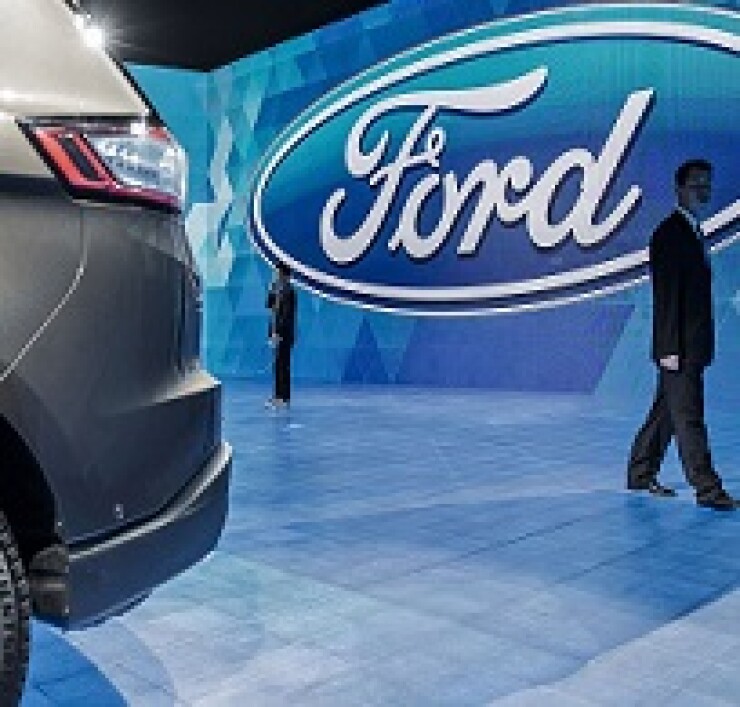(Bloomberg)-- Ford Motor Co., which has been losing ground in the white-hot small sport utility vehicle segment, is trying to get back in the game with a ground-up redesign of its aging Escape model.
The automaker is introducing the new Escape at events Tuesday in China and Europe, following an elaborate introduction near its headquarters in Dearborn, Michigan. Making a splash with the vehicle -- Ford’s second-best seller -- in an increasingly competitive segment is key to the broader restructuring of its business away from sedans and into SUVs.
“When we entered this segment in 2001, there were only six entries,” Kumar Galhotra, president of Ford’s North American operations, said at the Dearborn introduction. “Today there are 22 and soon we expect there to be 30.”

The Escape -- sold as the Kuga in many markets outside the U.S. -- is the linchpin of an expanding set of SUVs that’s key to Ford’s shift away from sedans to concentrate on crossovers, sport utes and trucks. Cars such as the Fiesta, Focus and Fusion models that once formed a pillar of the lineup are being retired to make way for beefier vehicles such as the Escape, the larger Explorer and the Ranger mid-size pickup.
The success of the first redesign of the Escape in seven years is critical to the $11 billion restructuring being engineered by Chief Executive Officer Jim Hackett. While Ford shares are up this year, they’re down about 19 percent since he took over the job in May 2017.
The sneak peek the company gave to media last week was a circus-like roll-out complete with jugglers, dancers, singers, basketball players and gymnasts. It’s no wonder the unveil was a bit over-the-top, as the Escape faces a challenge standing out in an increasingly crowded market and catching up to the likes of Toyota’s RAV4 and Honda’s CR-V. Since 2012, the Escape has lost nearly 7 points of market share, dropping from the No. 2-selling compact SUV to No. 5. Last year, U.S. sales fell 12 percent.
“Things are moving so fast now, you can’t afford to have old technology and an old, stale design,” said Jeff Schuster, senior vice president of forecasting for LMC Automotive. “This is a very important segment for Ford, and it’s important that they remain competitive as a significant number of new models come into the market.”
Four years ago, compact SUVs surpassed mid-size sedans like the Toyota Camry to become the largest automotive segment. As buyers abandon passenger cars, they’re most often choosing compact SUVs for their higher ride height, ample cargo space and decent fuel economy.
By 2022, LMC Automotive predicts compact SUV sales will top 3 million in the U.S., nearly double what they were a decade earlier. The number of product offerings in the segment is expected to double in the next four years, according to the researcher.
Ford will play a part of that product proliferation, as it’s adding a small SUV to its lineup next year. Known internally as the “Baby Bronco,” Schuster said the model will resurrect the Maverick name Ford used in the 1970s. It’ll be aimed at the rugged off-roading crowd that now drives Jeep Wranglers. Ford also is bringing back its bigger Bronco SUV in 2020 with the same tough-mudder image.
This brewing sibling rivalry probably will keep Escape from ever reaching the heights reached in 2013, when it was the second-best selling compact SUV in America, behind the Honda CR-V, and captured 16.4 percent of the segment, LMC’s Schuster said. Last year, Escape had 9.6 percent share. The new model may take that up to 10.8 percent in 2020, before starting to lose ground again to newer rivals, LMC predicts.
The latest Escape features a sleeker, shark-nosed look and new technology such as an optional 8-inch dashboard touch screen, 4G wi-fi connectivity and semi-autonomous safety features like automatic emergency breaking. It’s lower, longer and 200 pounds lighter, which should improve fuel economy.
“In our business, the word we fear most is the dreaded c-word: being commoditized,” Hau Thai-Tang, Ford’s product development chief, said at the Escape introduction. “To really offset the tyranny of commoditization, what we want to do is have a clearly differentiated point of view. We’ve done that with Escape by repositioning it toward the very modern urban on-road customer.”
The automaker is counting on that more modern interpretation to attract urban professionals, especially woman, who currently are a minority of Escape buyers. One part of that strategy involves bringing back a gasoline-electric hybrid version dropped in 2012, and also adding a plug-in hybrid. Ford expects those engine options to account for as much as 27 percent of Escape sales.
Low gasoline prices have been turning buyers away from classic fuel sippers like the Toyota Prius hybrid. Ford plans to pitch prospective buyers on the convenience aspect, noting the new hybrid Escape will go 550 miles on a single tank of gas, but still is capable of towing up to 1,500 pounds.
Beyond the hybrid offerings, the high-end Titanium version of Escape will feature a 250 horsepower engine that’s the model’s fastest ever, while less-expensive versions will have a 1.5-liter engine that can shut off one cylinder to save gas.
Ford will release prices for the new model closer to when it goes on sale in the fall. The current Escape starts at $24,105, but quickly climbs above $30,000 with options.
“This is really the hot segment and it’s really important to Ford,” Schuster said. “It has become the bread-and-butter segment that essentially has taken over from the mid-sized sedans of yesteryear.




